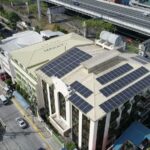The Resilient Local Government Unit Program of the City Government of Naga
Hon. John G. Bongat, Mayor, Naga City, Philippines
Date: May 27, 2019

Naga City in the Philippines, has been a Local Government Unit (LGU) Partner in the National Resilience Framework (Phase 1 – Other LGU Partners: Bataan Province, Cagayan de Oro City, Iloilo City, Iriga City, Ormoc City, Valenzuela City, Naga City, and Zamboanga City), which serves to provide LGU with a comprehensive governance framework in the creation of Resilient Government Systems.
A proactive collaboration between the academe, policy makers, and other stakeholders has shaped a science-based governance which deployed Integrated Risk Assessment and Resilience Scorecards. Strong leadership mobilised the government and business/industry and civil society in addressing resilience inclusively through: 1) Multi-stakeholder and Community-driven Resilience Planning, Budgeting, and Financing and Public Private Partnership.
The City’s Resilience Council headed by the Local Chief Executive led departments in Human Development, Local Economy, Infrastructure and Environment in addressing cross-sectoral resilience building in the City.
Through coherence multi-level (national and subnational) governance, the City has established systemic resilience to ensure the continuity of development.
BEST PRACTICE COMPONENTS
| Key Climate Challenges | Climate-based disaster which caused deaths and damages to property and infrastructure. |
| Policy and Governance Related to the Activity / Program
|
The Resilience Framework of the Philippines (Figure 1) emphasises Leadership and Governance in resilience to produce Immediate Outcomes and long-term Impacts. The Framework addressed Immediate Outcomes in the aspects of Human Development, Local Economy, Infrastructure, and the Environment. The longer-term Impacts would be on Resilient Government Systems, Reduced Deaths, Damages to Property, Infrastructure and Agriculture, which contributed to Development Continuity.
At the local government level, Naga City’s resilience has also been governed by Executive Order No. 2017-032, “Establishing The Naga City Resilience Council (NCRC), Defining Its Composition and Functions. The Naga City Resilience Council organisational structure in reflects resilience which underpins development componentswhich are clustered into: 1) Human Development; 2) Local Economy; 3) Infrastructure; 4) Environment. The Council is composed of the City’s existing government officials, a politician, and a representative of non-governmental organisation.
|
| Stakeholders in the Implementation
Financing of the Activity/Program |
The functioning of the Resilient LGU Model in the four resilience cluster components is supported by government offices and national level agencies, private sector, scientific communities/academe, and NGOs/CSOs. These stakholders. The extensive collaborations involved 20 government offices and national agencies, 7 private/business sector representative institutions, 10 academic institutions, and 11 NGOs/CSOs. |
| Beneficiary and number benefitted
|
Residents of Naga City |
| Methodology, Tools and Mechanisms
|
A Resilient LGU Model (Figure 2) has been established and is based on three pillars of: 1) Risk and Performance Assessment, 2) Competency Development, and the 3) Building of Strategic Partnerships and Coherence. The Model operates with tools and mechanisms of:
· Integrated Risk Assessment · Resilience Scorecards · Leadership Program · Institutional Capacity Development · Multi-stakeholder and Community-driven Resilience Planning, Budgeting, and Financing · Public Private Partnership · National-Subnational-Local Coherence · Workhsop/Meeting/Forum (National and Local levels) – Naga City Resilience Council Meetings/Workshops/Symposia – Resilience Marketplace for Innovation Forum – National Conference on Investing in Climate and Disaster Resilience |
| Technologies used by and Technological aspects of the Activity / Program | |
| Targets, Results and Achievements
|
· City Government Resilience System has been established that is science-based and inclusive to address cross-sector development components—Human Development, Local Economy, Infrastructure, and the Environment.
· Public-private partnership was concerned in the broader spectrum of resilience, including business continuity planning. |
| Key factor Contributing to Success
|
· A proactive collaboration between Naga City Government, academe, policy makers, the private sector, and NGOs/CSOs in informed and science-based resilience governance.
· A multisectoral council to assess and review the resilience status of the city in general, focusing on the local economy, human development, infrastructure, and environmental aspects. |
| Sustainability Issues and Challenges of the Activity/Program | 1. Decoding “scientific language” for policies and programs formulation
2. Encouraging more private sector participation 3. Bringing together the agencies in the public sector 4. Sustainability of public-private partnership |



